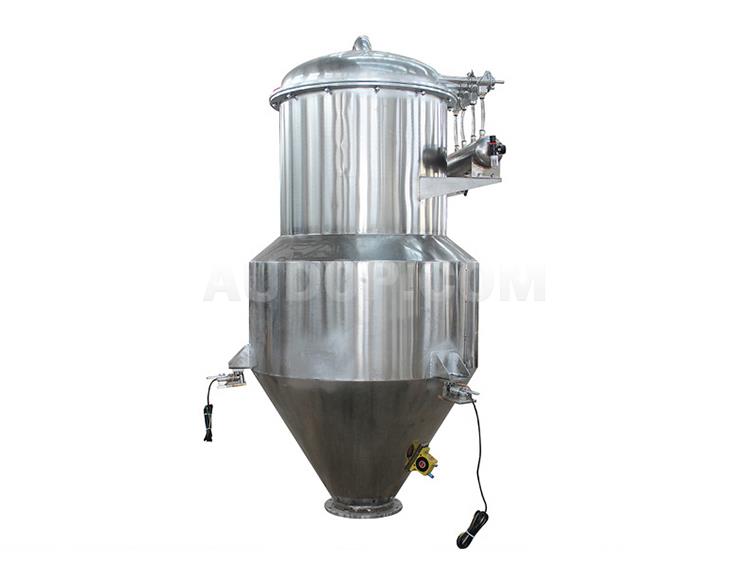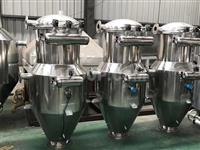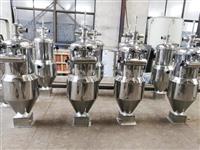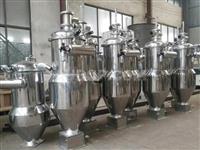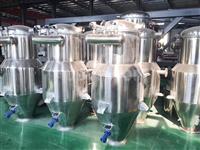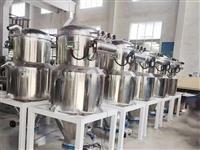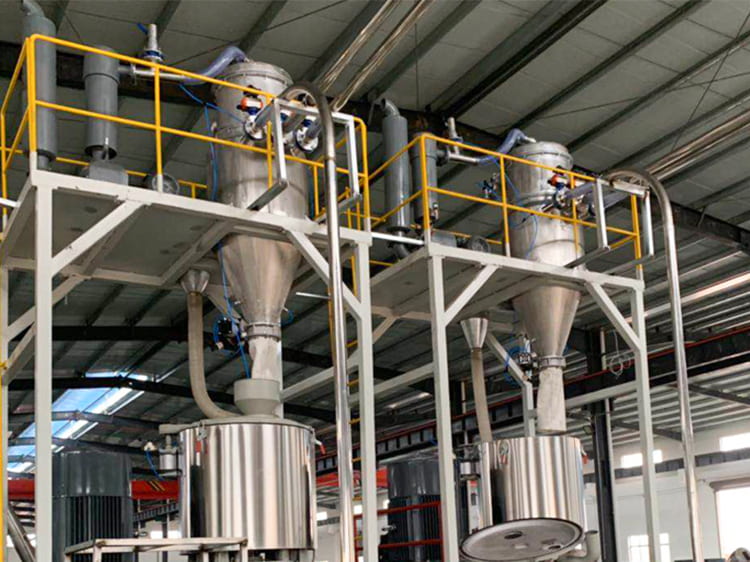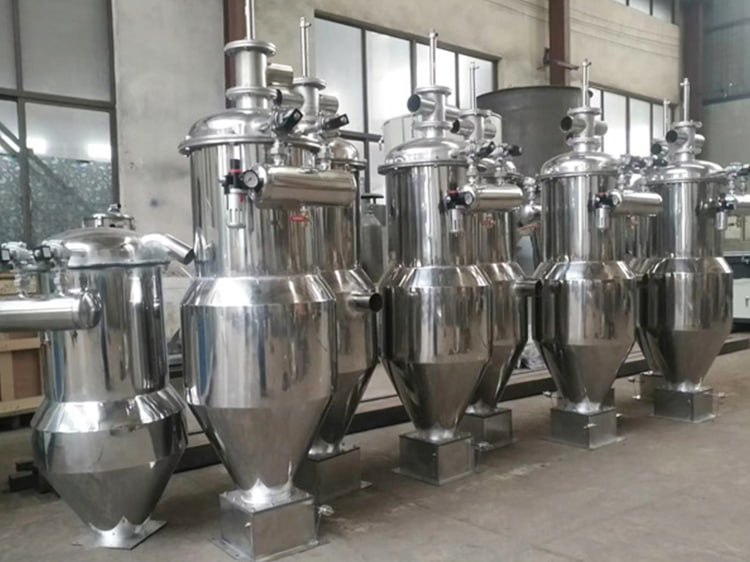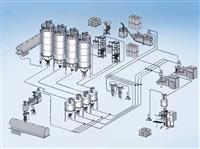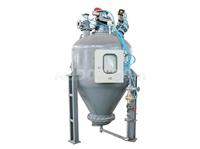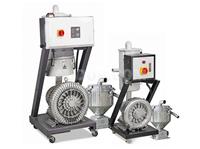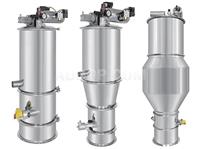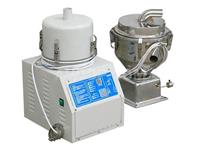Vacuum Feeder
- Simple and automatic control, with arbitrary setting of suction time, easy and convenient operation.
- Hygienic closed conveying, no dust leakage, no cross-contamination, in line with GMP standards, and sterile equipment can be provided.
- It occupies a small space, can complete the conveying of powders in narrow spaces, makes the working space neat and elegant, and is not limited by the length of the distance.
- Clean and dust-free operation, no dead ends, and quick and convenient disassembly, assembly, cleaning, and material change.
- Economical: One machine can be used for multiple sets of equipment in turn, with high efficiency and energy saving, no need for warm-up and standby, and low operation and maintenance costs.
Overview
The vacuum feeder is composed of an oil-free and water-free vacuum pump, a stainless steel suction nozzle, a conveying hose, a PE filter (or 316L stainless steel filter), a compressed air backblowing device, a pneumatic discharge door device, a vacuum hopper, and an automatic material level control device. The entire system is reasonably designed and exquisitely manufactured.
Vacuum feeders are divided into two types: intermittent discharge and continuous discharge. Intermittent discharge is conducive to reducing the investment cost of equipment and facilitating material level control. In most cases, we recommend users to adopt the intermittent discharge type. Continuous discharge is generally used for vacuum conveying of materials in long-distance and high-yield scenarios.
The vacuum feeder is a vacuum conveying equipment for powdery materials, granular materials, and powder-granule mixtures. It can automatically convey various materials into the hoppers of equipment such as silos, packaging machines, injection molding machines, and crushers. It can also directly convey mixed materials into mixers (such as V-type mixers, two-dimensional mixers, three-dimensional mixers, etc.), which reduces the labor intensity of workers and solves problems such as dust overflow during feeding.
Also known as a vacuum conveyor, the vacuum feeder is a dust-free closed pipeline conveying equipment that transports granular and powdery materials by means of vacuum suction. It utilizes the air pressure difference between the vacuum and the ambient space to form gas flow in the pipeline, driving the movement of powdery materials to complete the conveying of powders. China has introduced foreign vacuum technology, continuously improved and refined it, and now it is widely used in various light and heavy industries such as chemical engineering, pharmaceuticals, food, metallurgy, building materials, and agriculture and sideline industries.
Vacuum conveying is a closed pipeline conveying method. This conveying method can avoid dust pollution to the environment, improve the working environment, and at the same time reduce the pollution of materials by the environment and personnel, improving cleanliness. As it is pipeline conveying, it occupies a small space, can complete the conveying of powders in narrow spaces, and makes the workshop space neat and elegant. Especially, it is not limited by the length of the distance. At the same time, the vacuum feeder can reduce manual labor intensity and improve work efficiency.
Working Principle of Vacuum Feeder:
The vacuum feeder is a type of vacuum conveyor that uses an electric vacuum pump as the vacuum source. With this vacuum feeder, materials can be directly sent from containers into mixers, reactors, hoppers, tablet presses, packaging machines, vibrating screens, granulators, wet granulators, dry granulators, and crushers. This machine reduces the labor intensity of workers, eliminates dust pollution, and ensures production.
The vacuum feeder uses a vortex air pump to extract air, making the inlet of the suction nozzle and the entire system in a certain negative pressure state. The powder and granular materials are sucked into the suction nozzle together with the external air to form a material-air flow, which reaches the hopper through the suction pipe, and gas-material separation is carried out in the hopper. The separated materials enter the material-receiving equipment. Feeding and discharging are completed by the continuous opening and closing of the pneumatic directional valve, and the opening and closing of the pneumatic directional valve is controlled by the control center.
The vacuum feeder is equipped with a compressed air backblowing device. During each discharge, the compressed air pulse backblows the filter to knock off the powder adsorbed on the surface of the filter, so as to ensure the normal operation of suction.
For the vacuum feeder with material level control, the automatic feeding of materials in the hopper of the material-receiving equipment is completed through a level gauge. When the hopper of the material-receiving equipment is higher than a certain position, the vacuum feeder stops and enters the standby state; when the material level is lower than a certain position, the vacuum feeder starts automatically to complete the feeding of the material-receiving equipment.
Advantages of Vacuum Conveyor:
- The conveying pipes of the pneumatic vacuum feeder can be flexibly configured, making the factory's production process more reasonable;
- The conveying system is fully enclosed, with minimal dust flying and escaping, ensuring environmental hygiene;
- It has few moving parts, making maintenance convenient and easy to achieve automation;
- It has high bulk material conveying efficiency, reducing packaging, loading, unloading, and transportation costs;
- It can prevent the conveyed materials from being dampened, damaged, or mixed with other impurities, thus ensuring the conveying quality;
- During the conveying process, multiple process operations can be realized simultaneously, such as mixing, crushing, classification, drying, cooling, dust removal, and other chemical reactions;
- It can realize long-distance operation of conveying materials concentrated at multiple points to one place or distributing materials from one place to multiple points;
- The pneumatic vacuum feeder has a simple structure, which is convenient for manufacturing, processing, and installation, with low control costs and short construction time;
- It has high conveying efficiency, and there is no return transportation for the equipment;
- It is conducive to realizing bulk transportation, saving packaging materials and transportation costs;
- During the conveying process, intermediate treatments such as sorting and drying can also be carried out independently;
- It can convey materials in a heated state and play a cooling role during the conveying process.
Maintenance of Vacuum Feeder:
Before starting the machine, a preliminary inspection of the vacuum feeder should be carried out. The main inspection is to check the sealing of relevant parts such as the suction valve of the vacuum pump and pipe joints. Only when the sealing is good can it be ensured that the equipment will not have faults in the subsequent work and the work can be carried out stably.
Observe the internal working condition of the feeder. Once abnormal conditions occur or the internal vacuum degree decreases, the machine should be shut down in time and the machinery should be overhauled. If any parts are found damaged, they should be replaced immediately. In addition, the vacuum pump also needs to be cleaned at any time to keep the inside of the pump clean at all times.
After the equipment is used, attention should be paid to cleaning the vacuum feeder, and a comprehensive cleaning should be done, and all parts should be inspected.
Technical Parameters
Technical Parameters
| Model | Power (kw) | Delivery Value(kg/h) | Feed Inlet Diameter(mm) | Pressure(Mpa) | Specific Air Consumption(NL/min) | Size(mm) |
| ZKS-1 | 1.5 | 400 | φ38 | 0.4-0.6 | 500 | φ290×802 |
| ZKS-2 | 2.2 | 600 | φ39 | 0.4-0.6 | 500 | φ290×802 |
| ZKS-3 | 3 | 1200 | φ51 | 0.4-0.6 | 500 | φ290×952 |
| ZKS-4 | 5.5 | 2500 | φ51 | 0.4-0.6 | 500 | φ420×1216 |
| ZKS-6 | 5.5 | 3200 | φ51 | 0.4-0.6 | 500 | φ420×1216 |
| ZKS-7 | 7.5 | 6000 | φ63 | 0.4-0.6 | 500 | φ420×1379 |
| ZKS-10-6 | 7.5 | 6000 | φ76 | 0.4-0.6 | 500 | φ600×1907 |
| ZKS-20-5 | 11 | 5000 | φ102 | 0.4-0.6 | 500 | φ600×2070 |
Your requirements are the basis for our development and a daily challenge to bring to fruition, please do not hesitate to inquiry us.
Positive Pressure Conveying System
- The positive pressure conveying system is convenient for installing branch pipelines, which can convey materials to multiple places at the same time, with high production efficiency.
- The air leakage position of the positive pressure conveying system is easy to find, and the dust removal requirement for air is not high.
- The system has small conveying resistance and less wear on the pipeline.
- The positive pressure conveying system has a long conveying distance, which can reach more than 1000m.
- Air supplement pipes can be installed inside and outside the conveying pipeline, and air supplement and blockage removal can be carried out in a variety of ways.
Pneumatic Conveying Pump
- High Energy Efficiency: Due to the reasonable fluidization structure, the material fluidization state is good, and the air consumption is significantly lower than that of similar products. After years of production and research, our company has improved the fluidization structure for many times, which greatly improves production efficiency and reduces energy consumption, helping users save operating costs.
- High Material-Gas Ratio: With good fluidization effect and low air consumption, the material-gas ratio is naturally high. Through laboratory tests, when the equivalent distance is within 500 meters, the material-gas ratio can reach more than 30Kg (ash)/Kg (gas), ensuring efficient material conveying.
- Low Material Flow Rate: The material flow rate during conveying is low, which results in small wear of the equipment's valves and pipelines and long service life of vulnerable parts, reducing the frequency of equipment maintenance and replacement.
- Strong Adjustment Function: It has various adjustment methods such as primary and secondary air intake adjustment, which can make the system operate under the optimal air consumption ratio and excellent fluidization state, adapting to different material conveying conditions.
- Unique Blockage Removal Method: It adopts a back-suction blockage removal method, which is simple, easy to implement and reasonable in operation. It only needs to lead the material-gas mixture to the silo or flue inlet through the blockage removal valve and pipeline, ensuring smooth operation of the conveying system.
- Easy Solution for Supporting Facilities: Due to low air consumption and low speed, the silo material-gas separation and filtration equipment can be smaller than that equipped with general bin-type pumps, and the air pollution caused is also small, meeting environmental protection requirements.
- Small Energy Consumption Coefficient: The energy consumption coefficient of the bin-type pump conveying system is below 65KW.h/t.m, which is more energy-saving compared with similar conveying systems.
- High Degree of Automation: It adopts a programmable (PLC) control system, and the entire working process can be fully automated. The system can be set to automatic or manual operation mode. The main control cabinet is installed in the system control room, reducing manual operation intensity and improving operation accuracy.
High-Power Vacuum Loader
- High-Power Vacuum Loader is a model specially developed for scenarios with large material consumption, catering to the high-volume material needs of industrial production.
- The motor power, feeding pipe diameter and hopper capacity all adopt enlarged configurations to meet the material handling requirements of large-scale industrial operations.
- Equipped with microcomputer control, it provides material shortage and overload alarms, ensuring safe and reliable operation of the material conveying system.
- It has a small size, occupies little space and features flexible operation, making it easy to integrate into different industrial production line layouts.
- Customizable one-machine multi-hopper type vacuum loaders are available to meet the diverse material conveying needs of different industrial production lines.
Electric Vacuum Feeder
- The power source of the whole set of equipment is compressed air, and no power supply is used;
- The equipment is easy and simple to disassemble and clean;
- The equipment operates with very low noise and does not generate heat or oil pollution;
- The powder conveying process is carried out in a closed environment, without dust leakage.
Split-Type Vacuum Loader
- The split-type vacuum loader is equipped with a stainless steel hopper, which ensures that raw materials are not contaminated during the conveying process.
- It adopts microcomputer control, featuring easy operation and precise control. Additionally, it is equipped with multiple alarm indicator lights to promptly remind operators of equipment status.
- The motor protection device of the split-type vacuum loader can extend its service life. The material shortage alarm can proactively notify customers to resolve the issue in a timely manner.
- It is equipped with an independent filter device for easy removal of accumulated dust; the filter inspection window allows customers to check the usage status of the filter and perform regular cleaning, ensuring the equipment's stable operation.
- The vacuum hopper (YMH) of the split-type vacuum loader can be directly installed on the hopper of the molding machine; the electric eye hopper (YVH) can be directly installed at the feed inlet of the molding machine, facilitating integration with production lines.
- A cyclone dust collector can be optionally configured for the split-type vacuum loader, which reduces the frequency of filter cleaning and is suitable for crushed material conveying.
- The YPV-U European-style two-material proportional valve (including an optional control box) can be optionally configured for the split-type vacuum loader, which is used for mixed use of new materials and crushed materials or immediate recycling of crushed materials.
- When crushed materials account for more than 30% of the conveyed raw materials, it is recommended to select a 14-mesh stainless steel filter screen for the split-type vacuum loader to ensure smooth conveying.
